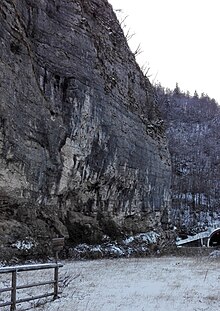Ripari Villabruna
Ripari Villabruna | |
 | |
 location in Italy | |
| Location | near Feltre |
|---|---|
| Region | Cismon valley, province of Belluno, Italy |
| Coordinates | 46°05′03.4″N 11°45′51.6″E / 46.084278°N 11.764333°ECoordinates: 46°05′03.4″N 11°45′51.6″E / 46.084278°N 11.764333°E |
| Type | Abri |
| History | |
| Cultures | Epigravettian, 14,000 years ago |
| Associated with | Cro-Magnon |
| Site notes | |
| Excavation dates | late 1980s |
| Archaeologists | Giuseppe Vercellotti |
Ripari Villabruna is a small rock shelter in northern Italy with mesolithic burial remains. It contains several Cro-Magnon burials, with bodies and grave goods dated to 14,000 years BP. The site has added greatly to the understanding of the neolithic development of medical[1] and religious practises in early human communities.[2][3]
History[]
The ablation and removal of debris in the Cismon valley, in the Sovramonte municipality, province of Belluno, Italy during the late 1980s led to the discovery of several rock shelters (abris). Located at a height of 500 m (1,600 ft) above sea level they show impressive traces of the settlement by prehistoric people and their activities. The rock shelters, named after their discoverer "Ripari Villabruna", are part of a complex system of sites that reach from the lowest points of the valley to alpine heights. Excavations confirm that humans frequently occupied the site for short periods in a late Epigravettian cultural context, carbon dated to begin around 14,000 years ago and continuing to the middle of the ensuing Holocene.[4]
Villabruna 1[]

A grave that contained a well-preserved skeleton was discovered at the base of the archaeological layers in 1988. Direct AMS dating of the skeletal remains revealed an age of 14,160 to 13,820 years. The burial took place during the first stages of the human settlement in the rock shelters. The corpse was placed into a narrow, shallow pit of 30 to 40 cm (12 to 16 in) depth, the head turned to the left with arms stretched touching the body.[5]
Six grave attachments were placed to the body's left. The typical equipment of a hunter-gatherer included a fire stone knife, a fire stone core, another stone as hammer, a blade of fire stone, a bone tip, a pellet of ochre and Propolis (a resinous matter, produced by bees). Limestone platelets decorated with ochre drawings had been placed on top of the tomb.[6]
The excellent preservation of the Villabruna 1 skeleton helped to thoroughly investigate various aspects of skeletal biology, such as body size, craniofacial morphology, tooth wear, functional anatomy, and nutritional and pathological aspects. Comparing Villabruna 1 and similar finds with today's people widened the understanding of biocultural adjustments, the living conditions and survival strategies of the Paleolithic population of Europe.[7]
Villabruna 1 is significant in terms of the history of population genetics: the remains were found to carry Y-DNA haplogroup R1b1a-L754* (xL389,V88). This is the oldest documented example of haplogroup R1b found anywhere.[8]
References[]
- ^ Giuseppe Vercellotti, The Late Upper Paleolithic skeleton Villabruna 1 (Italy): a source of data on biology and behavior of a 14.000 year-old hunter, Journal of Anthropological Sciences, v.86, 143-163 (2008).
- ^ Andrew Clifford, The Geologic Model of Religion (Andrew Clifford, 2012) p134.
- ^ Antonio Beltrán, Paleoantropologia e preistoria: origini, paleolitico, mesolitico (Editoriale Jaca Book, 1993) [1].
- ^ "The Sheds Villabruna". Archeoagordo.it. Retrieved January 9, 2017.
- ^ "The Late Upper Paleolithic skeleton Villabruna 1" (PDF). Ista-org.com. Retrieved January 9, 2017.
- ^ "Les Abris Villabruna dans la Vallée du Cismòn" (PDF). muse.it. Retrieved January 11, 2017.
- ^ "Ripari Villabruna, Italien - evolution-mensch de". Evolution-mensch.de. Retrieved January 9, 2017.
- ^ haplogroup.info
External links[]
- Archaeological sites in Veneto

